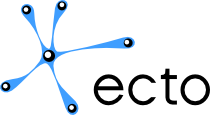Serialization: Create From Python, Load/Execute From Pure C++¶
To allow such things as saving the state of a plasm, or network transport between cells, ecto supports boost::serialization of tendrils,cells, and plasms.
- Steps to ensure your types can be serialized:
- Write boost serialization methods for your types, don’t worry all the basic types should work by default.
- Use the
ECTO_REGISTER_SERIALIZERSin one of your translation units.
-
ECTO_REGISTER_SERIALIZERS(Type)¶
Sample:
#include <ecto/ecto.hpp>
struct Point
{
float x,y,z,n;
template<typename Archive>
void serialize(Archive& ar, const unsigned int version)
{
ar & x & y & z & n;
}
};
ECTO_REGISTER_SERIALIZERS(Point);
//... more ecto code.
Embedding ecto in a c++ program¶
Assuming you have serializers for all your types, you may reliably serialize a graph from python and execute in a native cpp main.
Now that we have some ecto cells, like the ones in hello_ecto, we can write a python script that serializes the plasm to a text file.
#!/usr/bin/env python
import ecto #ecto core library
import ecto.hello_ecto as hello_ecto #a user library, that has a few ecto modules
plasm = ecto.Plasm()
r = hello_ecto.Reader()
p1 = hello_ecto.Printer(str="default")
p2 = hello_ecto.Printer(str="default")
plasm.connect(
r["output"] >> (p1["str"],p2["str"])
)
if __name__ == '__main__':
plasm.save('printy.plasm')
Our graph is the following:
![digraph G {
graph [rankdir=TB, ranksep=1]
edge [labelfontsize=8]
node [shape=plaintext]
0[label=<<TABLE BORDER="0" CELLBORDER="1" CELLSPACING="0" CELLPADDING="4"> <TR> <TD ROWSPAN="1" COLSPAN="1" BGCOLOR="khaki">hello_ecto::Reader</TD> </TR> <TR>
<TD PORT="o_output" BGCOLOR="indianred1">output</TD>
</TR> </TABLE>>];
1[label=<<TABLE BORDER="0" CELLBORDER="1" CELLSPACING="0" CELLPADDING="4"> <TR>
<TD PORT="i_str" BGCOLOR="springgreen">str</TD>
</TR> <TR> <TD ROWSPAN="1" COLSPAN="1" BGCOLOR="khaki">hello_ecto::Printer</TD> <TD PORT="p_str" BGCOLOR="lightblue">str</TD>
</TR> </TABLE>>];
2[label=<<TABLE BORDER="0" CELLBORDER="1" CELLSPACING="0" CELLPADDING="4"> <TR>
<TD PORT="i_str" BGCOLOR="springgreen">str</TD>
</TR> <TR> <TD ROWSPAN="1" COLSPAN="1" BGCOLOR="khaki">hello_ecto::Printer</TD> <TD PORT="p_str" BGCOLOR="lightblue">str</TD>
</TR> </TABLE>>];
0->1 [headport="i_str" tailport="o_output"];
0->2 [headport="i_str" tailport="o_output"];
}](../../../_images/graphviz-056d82dfcacaeb81ef109196507629e099c65a25.png)
Then a cpp file that can execute our printy.plasm file might look like:
#include <ecto/ecto.hpp>
#include <ecto/serialization/registry.hpp>
#include <ecto/serialization/cell.hpp>
#include <ecto/serialization/plasm.hpp>
#include <ecto/scheduler.hpp>
int
main()
{
ecto::plasm::ptr p(new ecto::plasm());
//load up our plasm
{
std::ifstream in("printy.plasm");
p->load(in);
}
//lets make some graphviz
{
std::ofstream graphviz("printy.plasm.dot");
p->viz(graphviz);
}
//iterate over all cells in the plasm.
std::cout << "** cell listing" << std::endl;
std::vector<ecto::cell::ptr> cells = p->cells();
for (size_t i = 0; i < cells.size(); i++)
{
std::cout << cells[i]->name() << std::endl;
}
//use a scheduler...
ecto::scheduler sched(p);
return sched.execute();
}
The cmake for this looks like:
#
# Copyright (c) 2011, Willow Garage, Inc.
# All rights reserved.
#
# Redistribution and use in source and binary forms, with or without
# modification, are permitted provided that the following conditions are met:
# * Redistributions of source code must retain the above copyright
# notice, this list of conditions and the following disclaimer.
# * Redistributions in binary form must reproduce the above copyright
# notice, this list of conditions and the following disclaimer in the
# documentation and/or other materials provided with the distribution.
# * Neither the name of the Willow Garage, Inc. nor the names of its
# contributors may be used to endorse or promote products derived from
# this software without specific prior written permission.
#
# THIS SOFTWARE IS PROVIDED BY THE COPYRIGHT HOLDERS AND CONTRIBUTORS "AS IS"
# AND ANY EXPRESS OR IMPLIED WARRANTIES, INCLUDING, BUT NOT LIMITED TO, THE
# IMPLIED WARRANTIES OF MERCHANTABILITY AND FITNESS FOR A PARTICULAR PURPOSE
# ARE DISCLAIMED. IN NO EVENT SHALL THE COPYRIGHT OWNER OR CONTRIBUTORS BE
# LIABLE FOR ANY DIRECT, INDIRECT, INCIDENTAL, SPECIAL, EXEMPLARY, OR
# CONSEQUENTIAL DAMAGES (INCLUDING, BUT NOT LIMITED TO, PROCUREMENT OF
# SUBSTITUTE GOODS OR SERVICES; LOSS OF USE, DATA, OR PROFITS; OR BUSINESS
# INTERRUPTION) HOWEVER CAUSED AND ON ANY THEORY OF LIABILITY, WHETHER IN
# CONTRACT, STRICT LIABILITY, OR TORT (INCLUDING NEGLIGENCE OR OTHERWISE)
# ARISING IN ANY WAY OUT OF THE USE OF THIS SOFTWARE, EVEN IF ADVISED OF THE
# POSSIBILITY OF SUCH DAMAGE.
#
add_executable(tutorial_native_plasm
native_plasm.cpp
)
target_link_libraries(tutorial_native_plasm
ecto
${catkin_LIBRARIES}
hello_ecto_ectomodule #uses cells from this module.
${CMAKE_THREAD_LIBS_INIT}
)
Running command like the following:
% ./serialize_plasm.py
% export PATH=PATH_TO_BIN:$PATH
% tutorial_native_plasm
Yields this output:
** cell listing
hello_ecto::Printer
hello_ecto::Printer
hello_ecto::Reader
h ello o q
h
h
ello
ello
o
o
